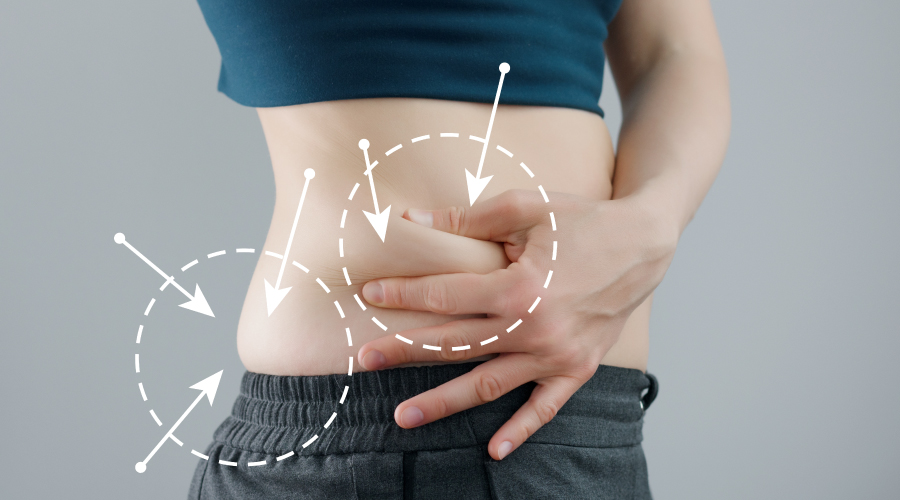

Let’s be real-no one likes the stubborn belly bulge. It hijacks your confidence, stretches your jeans, and no matter how much you try to shake off that fat, it seems very hard to budge. But beyond the surface lies something even more crucial: visceral fat.
Visceral fat, which is stored deep in the belly around essential organs like the liver and intestines, is one of the most dangerous types of fat. A silver lining is that you can learn how to reduce visceral fat by making a few smart lifestyle changes. Excess visceral fat can cause significant health problems.
What is Visceral Fat?
You might be wondering, what is visceral fat and how is it different from the fat you can see? Visceral fat, on the other hand, wraps around organs and releases dangerous chemicals. Subcutaneous fat is just under the skin. These chemicals can cause long-term inflammation, insulin resistance, and hormonal changes. Keeping your visceral fat level healthy is so essential for your long-term health.
Causes of Visceral Fat
A mismatch between calories consumed and burned is the leading cause of having too much visceral fat. But, when you eat more than your body burns, it stores the extra fat. Other things that may have played a role are:
- Sedentary lifestyle
- High intake of sugar and processed foods
- Excessive alcohol consumption
- Hormonal changes, particularly in postmenopausal women
- Genetic predisposition
The visceral fat range male is usually higher than that of females, and men are typically more likely to develop belly fat. However, due to hormonal fluctuations, the visceral fat range female rises after menopause.
Diagnosis: How to Measure Visceral Fat
Want to know how to measure visceral fat? Medical imaging like CT or MRI gives reliable results, but there are easier things you can do at home:
- Waist circumference: A waist size of more than 94 cm for men and 80 cm for women is considered significant.
- Waist-to-hip ratio: If the waist-to-hip ratio is more than 0.90 for men and 0.85 for women, you have belly fat.
- Waist-to-height ratio: The waist-to-height ratio of less than 0.5 is good.
- BMI: A BMI over 30 isn’t great, but it may mean you have a lot of visceral fat.
You can also learn how to calculate visceral fat using advanced body composition scales that give body fat percentages. After that, visceral fat makes up about 10% of your body fat.
The visceral fat normal range varies a little from person to person, but staying within that range is generally a good idea.
Read More: Struggling to Slim Down? Here’s How to Lose Weight Fast!
How to Get Rid of Visceral Fat
So how to reduce visceral fat exactly then? The key is to change your food, get more exercise, and generally live a healthier life. How to do it:
1. Exercise Regularly
Cardio and muscle training are helpful, but HIIT (High-Intensity Interval Training) works even better. More than steady-state exercise, it can help you burn visceral fat.
2 Healthy Eating
Cut back on saturated fats, sugar, and processed carbs. Eat lots of fruits, veggies, whole grains, and lean proteins. Diets like low-carb or Mediterranean can teach your body how to burn visceral fat as fuel.
3. Fast Intermittently
Eating during a limited time might help you burn fat and eliminate abdominal fat more quickly.
4. Reduce Stress, Sleep Better
Stress and insufficient sleep can raise cortisol levels, making it easier to store fat. Aim for 7–8 hours of sound sleep each night, and do things that help you relax, like yoga or meditation.
5. Drink Less and Quit Smoking
Too much booze makes belly fat worse. Cutting back on or giving up both can help lower your visceral fat level.
6. Consistency
Keep things the same. The best way to lose weight and get rid of abdominal fat for good is to make changes to your lifestyle that you can stick with.
Conclusion
Anyone who wants to improve their health and lower their risk of chronic disease must understand about visceral fat reduction ways. You can’t change your genes or age, but you can change what you do daily. Remember that small, consistent changes have the most significant effect when figuring out how to lose visceral fat. Today, take charge and support your body the way it needs it.
Frequently Asked Questions Related to Visceral Fat
Q1. How to reduce visceral fat?
Healthy eating and regular exercise, especially HIIT and strength training, are the greatest approaches to lose visceral fat. Sleeping and managing stress can also reduce visceral fat.
Q2. Is abdominal fat removal difficult?
Visceral fat is simpler to shed than subcutaneous. It breaks down faster and comes out through urine or sweat. After two to three months of daily exercise and healthy food, you should see results.
Q3. Will fasting reduce belly fat?
Unfortunately, not. Losing weight requires eating fewer calories than you expend. To lose fat, especially visceral fat, you must eat and exercise, especially strength-training.




